|
|
|
Sort Order |
|
|
|
Items / Page
|
|
|
|
|
|
|
| Srl | Item |
| 1 |
ID:
151592
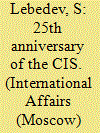

|
|
|
|
|
| Summary/Abstract |
Armen Oganesyan, Editor-in-Chief of International Affairs: This year, the CIS is 25 years old. There is a view that the CIS facilitated a civilized divorce of the Soviet republics. What do you think about it?
|
|
|
|
|
|
|
|
|
|
|
|
|
|
|
|
| 2 |
ID:
132355
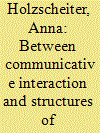

|
|
|
|
|
| Publication |
2014.
|
| Summary/Abstract |
This paper discusses contemporary engagement with the theory and analysis of discourse in international relations. It argues that discourse understood as "meaning in use" has emerged as one of the core concepts in constructivist scholarship, being of tremendous theoretical and analytical value. The paper identifies two distinct types of discourse analysis around which most contributions in this field converge: micro-interactional approaches that emphasize the communicative, pragmatic aspects of discourse and macro-structural approaches focusing on discourse as structures of signification. What unites these studies is their interest in the diffuse power relationships that characterize social interaction in international politics and the productive effects of power that the term "discourse" serves to underline. Through a combination of these two different strands of discourse research, with two different conceptualizations of power (deliberative and productive), the paper develops a taxonomy of discourse approaches that reflects four distinct variants of discourse research. These variants are illustrated by means of an in-depth discussion of recent innovative studies. In conclusion, the paper points to a number of limitations in the present conceptualization of power through discourse as well as in terms of the uneasy combination of positivist epistemology and constructivist ontology in much empirical discourse research. Discussing the overlap between discourse and practice scholarship, the paper sketches future directions for research in this field.
|
|
|
|
|
|
|
|
|
|
|
|
|
|
|
|
| 3 |
ID:
174543
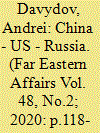

|
|
|
|
|
| Summary/Abstract |
This article describes the recent events in the relations between China, the United States, and Russia (the "Big Three" in the struggle to shape a new world order), their role and potentialities in the process under conditions of the raging coronavirus pandemic, and the development prospects for their relations in the foreseeable future.
|
|
|
|
|
|
|
|
|
|
|
|
|
|
|
|
| 4 |
ID:
072611
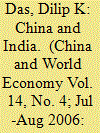

|
|
|
|
|
| Publication |
2006.
|
| Summary/Abstract |
As ancient civilizations China and India had close cultural and commercial ties, but they drifted apart after eleventh century until the mid-twentieth century. In the 1990s, the two emerging-market economies once again began to interact and become economically close. The bilateral relationship was strengthened by political initiatives and determination from both sides. Their mutual trade and investment are on the rise and their new relationship has been evolving in accordance with the new diplomatic stance of conciliation. The bilateral economic bonds are likely to involve both competitive and collaborative dimensions. The two neighbors have determined to develop more extensive cooperation in regional and international affairs.
|
|
|
|
|
|
|
|
|
|
|
|
|
|
|
|
| 5 |
ID:
146025
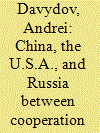

|
|
|
|
|
| Summary/Abstract |
The author analyzes sensitive issues (i.e. pressing problems) in mutual relations between China and Russia, and China and the U.S.A. He also assesses the development prospects of U.S.-PRC-RF ties amid a changing global architecture
|
|
|
|
|
|
|
|
|
|
|
|
|
|
|
|
| 6 |
ID:
114677
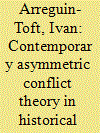

|
|
|
|
|
| Publication |
2012.
|
| Summary/Abstract |
This article offers an intellectual history of theoretical work devoted to explaining asymmetric conflict outcomes since World War II. Three factors are critical to understanding how the literature has evolved. First, the concept of "asymmetric conflict" encompasses a number of overlapping literatures, including insurgency, terrorism, counterinsurgency, and most recently, civil wars. Second, and interrelated, the field of inquiry has been unproductively divided between military and academic thinkers, with insufficient engagement between the two communities. Third, the popularity of the field of inquiry following the events of September 11, 2001, and the subsequent American-led military operations in Afghanistan (2001) and Iraq (2003) have resulted in analyses that are empirically rich, but have provided little in the way of theoretical advances. The conclusion offers an overall assessment of the field of inquiry into asymmetric conflict outcomes, suggested directions for future research, and a table of major contributors to the literature, their key questions, case universes, intended contributions, and theoretical limitations.
|
|
|
|
|
|
|
|
|
|
|
|
|
|
|
|
| 7 |
ID:
170943
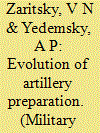

|
|
|
|
|
| Summary/Abstract |
This paper offers a history of preparing artillery for attack, and cites useful lessons of its organization and conduct still relevant to present-day local wars and armed conflicts
|
|
|
|
|
|
|
|
|
|
|
|
|
|
|
|
| 8 |
ID:
151603
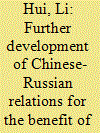

|
|
|
|
|
| Summary/Abstract |
CHINESE-RUSSIAN FRIENDSHIP is deeply rooted in historical realities. The People's Republic of China was proclaimed on October 1, 1949. On the next day, the PRC and the USSR established diplomatic relations, and the Soviet Union became the first country to officially recognize new China. During those years, Chinese-Soviet, and subsequently Chinese-Russian relations went through many trials and stood the test of time. Being stable, robust, and mature, they have become a model of intergovernmental relations in the modern world. Chinese-Russian relations have been currently going through the most favorable period in their history, maintaining their high level and thus benefitting the peoples of both countries.
|
|
|
|
|
|
|
|
|
|
|
|
|
|
|
|
| 9 |
ID:
128854
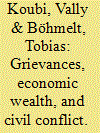

|
|
|
|
|
| Publication |
2014.
|
| Summary/Abstract |
One of the most robust findings in the literature on civil conflicts is that high income levels are associated with a lower risk of conflict onset. This article addresses the wealth-conflict link and discusses it in relation to the dominating `greed vs. grievance' dichotomy. It is further argued that the effect on conflict of grievances, in the form of horizontal inequalities, is conditioned on national wealth. More specifically, there may be a higher risk of civil war in those countries that have much wealth, but where a large share of the population is potentially excluded from accessing it. The empirical analyses testing this argument employ time-series cross-section data for 1951-2004 and find support for the theory. The authors also show that taking this conditional relationship into account improves our ability to predict the onset of civil conflict.
|
|
|
|
|
|
|
|
|
|
|
|
|
|
|
|
| 10 |
ID:
151041
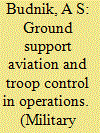

|
|
|
|
|
| Summary/Abstract |
The author reviews aviation's main tasks and ways to fulfill them while giving air support to the troops, as well as issues related to aircraft combat control in joint missions with the Ground Forces during military conflicts. Special attention is paid to functions performed by aviation control posts in preparing and resolving joint combat assignments with the Ground Forces.
|
|
|
|
|
|
|
|
|
|
|
|
|
|
|
|
| 11 |
ID:
065781
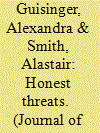

|
|
|
| 12 |
ID:
082784
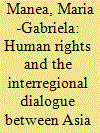

|
|
|
|
|
| Publication |
2008.
|
| Summary/Abstract |
Since the early 1990s, human rights have been a contentious issue for relations between the Association of Southeast Asian Nations (ASEAN) and the European Union (EU), especially in the Asia-Europe Meeting (ASEM). It is an issue that has constantly led to tensions in interregional cooperation. However, the ASEAN-EU dialogue on human rights has, in fact, had a significant impact on regional dynamics by stimulating the process of regional identity formation, especially in Southeast Asia. The core mechanism through which this development takes place is that of interaction, the process in which the two regional groupings engage while negotiating human rights policy. It can be argued, therefore, that interregional and intraregional human rights interactions are mutually dependent. ASEAN's rather confrontational mode of interaction with the European Union in relation to human rights has served as a catalyst for the dynamic growth of a collective definition of self in ASEAN. It has led to an 'essentialization' of ASEAN's idea of self as opposed to a common other, something which has undermined the possibility of maintaining an interregional dialogue that is not confrontational. However, it has also contributed to the development of a regional space for communicating about human rights and has thus played a central role in the gradual transformation of ASEAN's collective identity formation.
|
|
|
|
|
|
|
|
|
|
|
|
|
|
|
|
| 13 |
ID:
180236
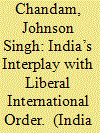

|
|
|
|
|
| Summary/Abstract |
India’s limited partnership with the liberal international order (LIO) of the post-Second World War period had seen a substantial transformation after the end of the Cold War through its economic integration with the world economy. At this critical time of liberal internationalism triggered by the relative decline of American hegemony, rise of the non-Western powers and the tendency of populism in the West, India’s role in the emerging order has been a fundamental imperative. The rationale for its comprehensive partnership with the liberal order rests on four main considerations: the looming threat to the liberal order and India’s role; consistency of India’s political principles with that of the liberal order; the concern for national interest, identity and global role; and finally, the absence of any viable alternative order. In spite of these promising values and necessities, India’s deeper integration has been constrained by three major factors. The first reason relates to the very concept of the LIO, which is slightly Western-oriented. The second reason corresponds to India’s core identity and its governing view with regards to the world—of non-alignment, sovereign autonomy, non-interference and civilisational identity. Finally, its maximum assimilation within the liberal order continues to be hindered by ‘domestic setbacks’.
|
|
|
|
|
|
|
|
|
|
|
|
|
|
|
|
| 14 |
ID:
079631
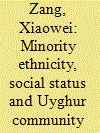

|
|
|
|
|
| Publication |
2007.
|
| Summary/Abstract |
Using a dataset (n = 4,012) from a 2001 survey in Xinjiang, I examine the effect of minority status and social status on neighbouring behaviour in urban China. Data analysis indicates that Uyghur Muslims are more neighbouring than Han Chinese. However, there is no evidence that the Uyghur approach to neighbourhood interaction can be attributed to Uyghur culture as many inter-group differences fade away once ethnic parity in social status is attained. I use my study to consider some methodological approaches used in research on ethnic behaviour in China.
|
|
|
|
|
|
|
|
|
|
|
|
|
|
|
|
| 15 |
ID:
100046
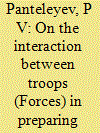

|
|
|
| 16 |
ID:
107265
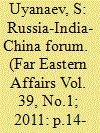

|
|
|
|
|
| Publication |
2011.
|
| Summary/Abstract |
The author reviews the short history, role, and significance of the forums drawing scholars in international affairs from Russia, India, and China every year to discuss the various aspects of cooperation between the three countries on the world stage in the economy and other fields. He makes a detailed analysis of the outcome of the 10th Academic Conference of the RIC countries in Moscow that opened a fourth round of such meetings. The article contains a summary of the conferees' principal suggestion and scientific conclusions they reached to give impetus to tripartite cooperation in the future.
|
|
|
|
|
|
|
|
|
|
|
|
|
|
|
|
|
|
|
|
|